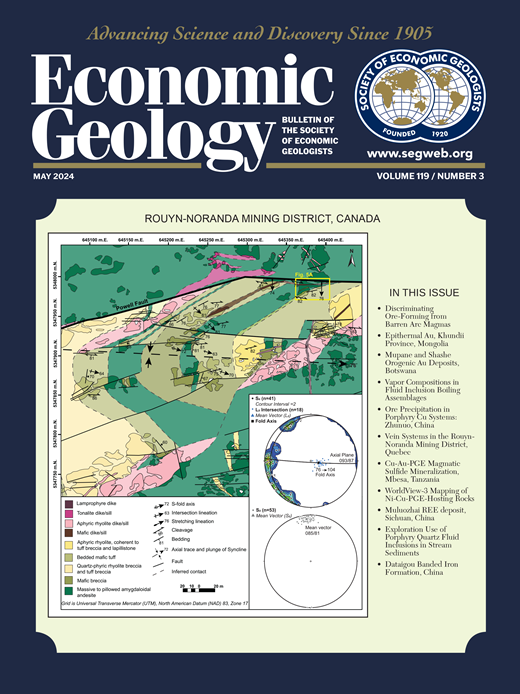Role of Mg Gangue Minerals in Natural Analogue CO2 Sequestration
IF 4.9
1区 地球科学
Q1 GEOCHEMISTRY & GEOPHYSICS
引用次数: 2
Abstract
Mineral carbonation reactions consume CO2 and thus have the potential for the long-term fixation of atmospheric CO2. This paper explores the possibility of integrating industrial-scale carbon storage into mining operations. Ultramafic rocks are typically considered to be one the most promising rocks for carbon capture and storage owing to their high content of Mg-bearing silicate minerals, such as forsterite (Mg2SiO4) and serpentine (Mg3Si2O5(OH)4). Beyond the thermodynamic considerations showing that magnesite (MgCO3) and quartz (SiO2) form from forsterite and serpentine alteration, the degree to which CO2 is carbonated depends on the kinetics of the reaction. For industrial carbon capture and storage to be viable, reasonable carbonation efficiency has to be achieved. To this effect, the reaction rates have to be increased, which can be achieved either by increasing the reactive surface area, increasing the reaction temperature, or using reagents to drive the reactions. However, these approaches are usually energy demanding or not efficient enough. As part of its activities, the mining industry excavates tens or hundreds of million metric tons of rock per mine and in certain areas these mafic rock groups can represent a significant percentage of the waste material left on the surface. This could represent a locally important source of readily available material for carbon capture and storage if the conversion process is sufficiently efficient. To test and quantify the carbonation potential of mine waste, a sample of serpentine skarn waste rock obtained from an iron ore mine in Sweden was reacted for 60 weeks in a laboratory humidity-cell test (HCT) at 20°C. The results show the dissolution of olivine, the precipitation of serpentine, an increase in the neutralization potential of the sample, and the appearance of inorganic carbon during the 60 weeks of testing. At ambient temperatures the sluggish precipitation kinetics of secondary phases will favor the formation of more hydrous Mg silicate phases, such as serpentine (Mg3Si2O5(OH)4), in place of Mg-bearing carbonates. This reaction lowers considerably the efficiency of forsterite carbonation, as only 25% of the Mg released from forsterite dissolution to form carbonate minerals. This study aims to model the carbonation efficiency of Mg silicates through the use of models supported by laboratory testwork and taking the example of a mine site in northern Sweden. This study evaluates the reaction of CO2 with Mg-bearing silicate rocks and the demonstration that carbonation reactions occur with Mg silicate wastes consuming CO2. Consequently, weathering of waste rock may well represent an important sink for carbon in the environment.镁脉石矿物在自然模拟CO2封存中的作用
矿物碳酸化反应消耗二氧化碳,因此具有长期固定大气二氧化碳的潜力。本文探讨了将工业规模的碳储存整合到采矿作业中的可能性。超镁质岩石通常被认为是最有希望捕获和储存碳的岩石之一,因为它们含有高含量的含镁硅酸盐矿物,如橄榄石(Mg2SiO4)和蛇纹石(Mg3Si2O5(OH)4)。除了热力学方面的考虑表明菱镁矿(MgCO3)和石英(SiO2)是由橄榄石和蛇纹石蚀变形成的,二氧化碳的碳化程度取决于反应的动力学。为了使工业碳捕获和储存可行,必须实现合理的碳化效率。为了达到这个效果,必须提高反应速率,这可以通过增加反应表面积、提高反应温度或使用试剂来驱动反应来实现。然而,这些方法通常需要消耗能源,或者效率不够高。作为其活动的一部分,采矿业每个矿山挖掘数千万或数亿公吨的岩石,在某些地区,这些基性岩石群可以代表留在地表的废物的很大比例。如果转换过程足够有效,这可能是当地一个重要的现成碳捕获和储存材料来源。为了测试和量化矿山废物的碳化潜力,从瑞典的一个铁矿中获得的蛇形矽卡岩废物岩石样本在20°C的实验室湿池测试(HCT)中反应了60周。结果表明,在60周的测试过程中,样品中橄榄石溶解,蛇纹石沉淀,中和电位升高,无机碳出现。在环境温度下,次生相的缓慢沉淀动力学将有利于形成更多含水的镁硅酸盐相,如蛇纹石(Mg3Si2O5(OH)4),以取代含镁碳酸盐。这一反应大大降低了forsterite碳酸化的效率,因为只有25%的Mg从forsterite溶解中释放出来形成碳酸盐矿物。本研究旨在通过使用实验室测试工作支持的模型,并以瑞典北部的一个矿场为例,对镁硅酸盐的碳化效率进行建模。本研究评价了CO2与含镁硅酸盐岩的反应,并论证了硅酸镁废弃物消耗CO2会发生碳酸化反应。因此,废石的风化作用很可能是环境中碳的重要汇。
本文章由计算机程序翻译,如有差异,请以英文原文为准。
求助全文
约1分钟内获得全文
求助全文
来源期刊

Economic Geology
地学-地球化学与地球物理
CiteScore
10.00
自引率
6.90%
发文量
120
审稿时长
6 months
期刊介绍:
The journal, now published semi-quarterly, was first published in 1905 by the Economic Geology Publishing Company (PUBCO), a not-for-profit company established for the purpose of publishing a periodical devoted to economic geology. On the founding of SEG in 1920, a cooperative arrangement between PUBCO and SEG made the journal the official organ of the Society, and PUBCO agreed to carry the Society''s name on the front cover under the heading "Bulletin of the Society of Economic Geologists". PUBCO and SEG continued to operate as cooperating but separate entities until 2001, when the Board of Directors of PUBCO and the Council of SEG, by unanimous consent, approved a formal agreement of merger. The former activities of the PUBCO Board of Directors are now carried out by a Publications Board, a new self-governing unit within SEG.
 求助内容:
求助内容: 应助结果提醒方式:
应助结果提醒方式:


